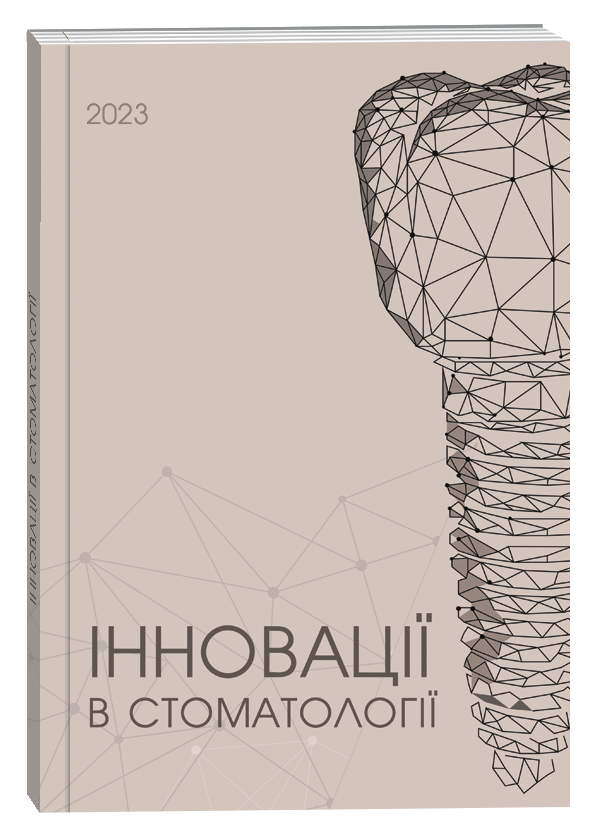RESEARCH OF THE ROLE OF TNFRSF11B, MTHFR AND TNFSF11 GENES IN CLEFT LIP AND PALATE
DOI:
https://doi.org/10.35220/2523-420X/2023.4.5Keywords:
cleft lip and palate, polymorphism, polymerase chain reaction, dentistry, genotypingAbstract
Congenital cleft upper lip and / or palate are the most common maxillofacial defects in humans, with an average incidence of 1 in 700 births worldwide. The prevalence of cleft upper lip and/or palate depends on geographical location, ethnicity, race, gender, and socio-economic status. The highest rate is observed among Asians (1:500), the average among Europeans (1:1000) and the lowest among the African population (1:2500), with the highest rate of 19.05:10000 for Japan and the lowest of 3.13:10000 for the Republic of South Africa. The prevalence of RG / P in Ukraine averages 1:1000 newborns, as in European countries, with a clear tendency to increase over the past decade. Purpose of the study. Identification of genetic factors that determine the tendency to form splits. Material and research methods. The study involved 20 patients aged 16–25 years. The main group consisted of 10 patients with complete or partial, unilateral and bilateral cleft upper lip and upper jaw defect; the control group included 10 healthy people. Genootyping of polymorphisms rs2073618 TNFRSF11B (OPG) 1181g>C, rs1801133 MTHFR 677c>T (Ala222Val) and rs2277438 TNFSF11 (RANKL) -438 A>G was performed in patients with complete or partial, one – and two-sided cleft upper lip and upper jaw defect and in the control group. The G allele of the rs2277438 polymorphism of the TNFSF11 gene encoding the osteoclast differentiation and activation factor RANKL was found to be associated with cleft formation. The homozygous GG genotype was also associated with an increased risk of cleft formation in the recessive inheritance model. The experimental and control groups did not significantly differ in the frequency distribution of genotypes and alleles of polymorphisms of the TNFRSF11B (osteoprotegerin) and MTHFR (methylenetetrahydrofolate reductase) genes. Conclusions. The rs2277438-438 A>G polymorphism of the TNFSF11 gene, which encodes an osteoclast differentiation and activation factor that plays a role in bone regeneration and remodeling, may be associated with the risk of cleft formation. This observation requires further verification in groups with a large number of patients.
References
Massenburg, B.B., Jenny, H.E., Saluja, S., Meara, J.G., Shrime, M.G., & Alonso, N. (2016). Barriers to Cleft Lip and Palate Repair Around the World. J Craniofac Surg, 27(7), 1741–1745 doi: 10.1097/SCS.0000000000003038.
Peter, E., & Larsen, D. (2004). Reconstruction of the Alveolar Cleft. Principles of Oral and Maxillofacial Surgery. Peterson’s second ed. m. Miloro, 2, 859–870.
Yang, J., Carmichael, S.L., Canfield, M., Song, J., & Shaw, G.M. (2008). National Birth Defects Prevention Study. Socioeconomic status in relation to selected birth defects in a large multicentered US case-control study. Am J Epidemiol, 167(2), 145–54. doi: 10.1093/aje/kwm283
Martín-Del-Campo, M., Rosales-Ibañez, R., & Rojo, L. (2019). Biomaterials for Cleft Lip and Palate Regeneration. Int J Mol Sci, 20(9), 2176 doi: 10.3390/ijms20092176
Walsh, P.S., Metzger, D.A., & Higushi, R. (2013). Chelex 100 as a medium for simple extraction of DNA for PCR-based typing from forensic material. Biotechniques, 54(3), 134–9.
Xiong, J., & O’Brien, C.A. (2012). Osteocyte RANKL: new insights into the control of bone remodeling. J Bone Miner Res, 27(3), 499–505.
Dougall, W.C. (2012). Molecular pathways: osteoclast-dependent and osteoclast-independent roles of the RANKL/RANK/OPG pathway in tumorigenesis and metastasis. Clin Cancer Res, 18(2), 326–335.
Assmann, G., Koenig, J., Pfreundschuh, M., Epplen, J.T., Kekow, J., Roemer, K., & Wieczorek, S. (2010). Genetic variations in genes encoding RANK, RANKL, and OPG in rheumatoid arthritis: a case-control study. J Rheumatol, 37(5), 900–4. doi: 10.3899/jrheum.091110.
Qian, B.P., Wang, X.Q., Qiu, Y., Jiang, J., Ji, M.L., & Feng, F. (2014). Association of receptor activator of nuclear factor-kappaB ligand (RANKL) gene polymorphisms with the susceptibility to ankylosing spondylitis: a casecontrol study. J Orthop Sci, 19(2), 207–212. doi: 10.1007/s00776-013-0528-5
Abdi, S., Bukhari, I., Ansari, M.G.A., BinBaz, R.A., Mohammed, A.K., Hussain. S.D., Aljohani, N., & Al-Daghri, N.M. (2020). Association of Polymorphisms in RANK and RANKL Genes with Osteopenia in Arab Postmenopausal Women. Dis Markers, 2020, 1285216. doi: 10.1155/2020/1285216
Abdi, S., Binbaz, R.A., Mohammed, A.K., Ansari, M.G.A., Wani, K., Amer, O.E., Alnaami, A.M., Aljohani, N., & Al-Daghri, N.M. (2021). Association of RANKL and OPG Gene Polymorphism in Arab Women with and without Osteoporosis. Genes (Basel), 12(2), 200. doi: 10.3390/genes12020200
Zhou, Y., Sinnathamby, V., Yu, Y., Sikora, L., Johnson, C.Y., Mossey, P., & Little, J. (2020). Folate intake, markers of folate status and oral clefts: An updated set of systematic reviews and meta-analyses. Birth Defects Res, 112(19), 1699–1719. doi: 10.1002/bdr2.1827
de Aguiar, P.K., Coletta, R.D., de Oliveira, A.M., Machado, R.A., Furtado, P.G., de Oliveira, L.A., & et al. (2015). rs1801133C>T polymorphism in MTHFR is a risk factor for nonsyndromic cleft lip with or without cleft palate in the Brazilian population. Birth Defects Res A Clin Mol Teratol, 103(4), 292–8. doi: 10.1002/bdra.23365
Saleem, K., Zaib, T., Sun, W., & Fu, S. (2019). Assessment of candidate genes and genetic heterogeneity in human non syndromic orofacial clefts specifically non syndromic cleft lip with or without palate. Heliyon, 5(12), e03019. doi: 10.1016/j.heliyon.2019.e03019








